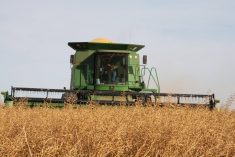The elimination of single desk marketing should increase barley acreage in Western Canada, says the Malting Industry Association of Canada.
President Phil de Kemp said proposed changes to the Canadian Wheat Board will allow malting companies to offer definitive price signals, something producers need when making annual cropping decisions.
“The industry is going to be able to signal to farmers immediately the prices (that maltsters) are prepared to pay for malting barley, and those prices will be reflective of the market on a daily and weekly basis,” de Kemp said.
Read Also

Crop quality looks good this year across Prairies
Crop quality looks real good this year, with the exception of durum.
“We’ll be able to provide cash on the barrel and farmers are going to know exactly the price they are going to receive with no hold-backs and no anticipation about what the final payments are going to be.”
The Canadian malting industry has been critical of CWB malting barley programs, suggesting they didn’t benefit farmers or malting companies.
De Kemp said CWB programs, including CashPlus, offered prices that didn’t truly reflect domestic and global markets, which fluctuate daily and weekly.
The CashPlus program offered single desk pricing but also gave producers the flexibility to negotiate directly with malting companies on freight costs, elevation, cleaning, premiums and storage.
Prairie growers committed 500,000 tonnes to the program in 2009-10, which accounts for 25 percent of the CWB’s total malting barley sales in any given year.
However, de Kemp said the malting industry still felt the program failed to provide definitive price signals that farmers are looking for when making cropping decisions and calculating net returns per acre.
He also said malting companies felt restricted in their ability to offer contract prices that were transparent, responsive and truly reflective of market values.
Malting companies would be more inclined to invest in Western Canada if the CWB no longer influenced malting barley contract prices, he added.
De Kemp said the domestic malting industry has long argued that amendments to the CWB Act in the late 1990s put them at a competitive disadvantage when buying barley.
“After those changes were made, we felt there was no ability or recourse back to government.… There was no arbitration, there was no mechanism for dispute resolution at all,” said de Kemp.
“So if you are a (global) company … and you have a tranche of money (for) upgrades or capacity expansions and new plants and you’ve got opportunities around the world, where are you going to go with them? There may be some good news stories coming down the line (for the western Canadian malting industry), but it’s going to take some time.”
Brian Otto, president of the Western Barley Growers Association, said he believes growers will also prefer working under the new environment, suggesting price transparency is a key issue when it comes to minimizing business risk.
“On my farm, when I want to do a malting barley contract, it is much more attractive to me when I know exactly what that crop is worth,” Otto said.
“When I deliver that malting barley and it meets specs, I know exactly what I’m going to get paid.”
He predicted that some malting companies will begin offering multiyear contracts to lock up acreage over a longer time frame.
“I certainly think barley acres are going to increase because we’re going to create a positive market environment, the industry will be able to give more transparent price signals, producers will know exactly what they’re dealing with and delivery opportunities will be better.”
Canada produces 1.8 to 2.2 million tonnes of malting barley in an average production year.
Fifty to 60 percent of that is normally sold to domestic maltsters, which process the barley and then sell it as finished malt.
Barley acres in Canada and the United States have fallen over the past decade or more, largely because of increased demand and better returns for oilseeds and corn, which have seen increased demand in food, feed and biofuel markets.
The significant price spread between malting barley and feed barley also discourages production because it places more financial risk on farmers if malting samples are rejected.
Canada’s barley acreage averaged more than 11.8 million acres per year between 1995 and 1999.
A decade later, between 2005 and 2009, average annual plantings were 9.6 million acres, a decrease of nearly 19 percent.
In 2010, plantings fell to 6.9 million acres, their lowest level since 1965, although Western Canada’s acreage was significantly hampered by excess spring moisture.
“We need barley acres,” said de Kemp. “We’ve got our work cut out for us but we feel that this is a great opportunity to try to grow the barley acres and the only way that we’re going to grow the barley acres is by showing the farmer competitive prices.”















